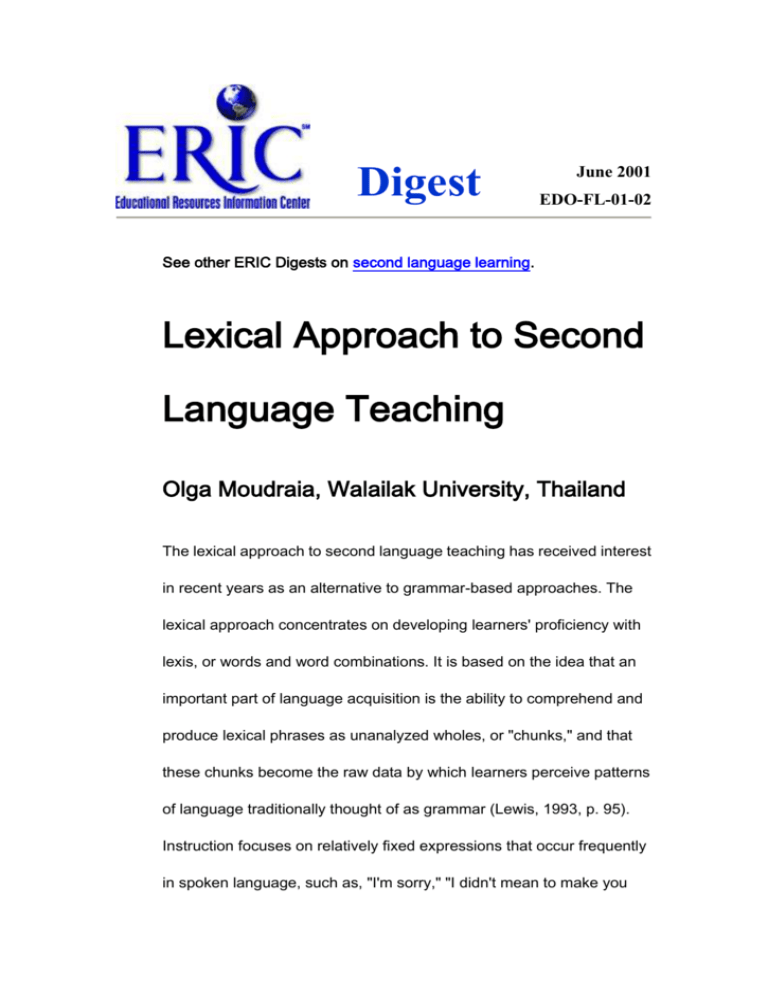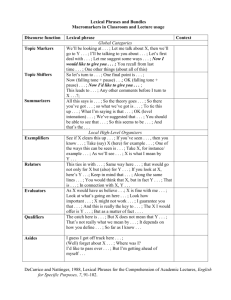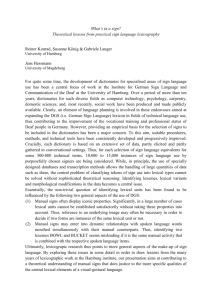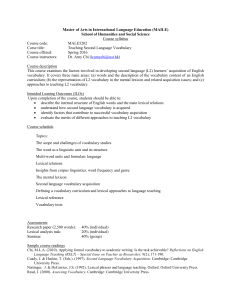Lexical Approach to Second Language Teaching
advertisement

Digest June 2001 EDO-FL-01-02 See other ERIC Digests on second language learning. Lexical Approach to Second Language Teaching Olga Moudraia, Walailak University, Thailand The lexical approach to second language teaching has received interest in recent years as an alternative to grammar-based approaches. The lexical approach concentrates on developing learners' proficiency with lexis, or words and word combinations. It is based on the idea that an important part of language acquisition is the ability to comprehend and produce lexical phrases as unanalyzed wholes, or "chunks," and that these chunks become the raw data by which learners perceive patterns of language traditionally thought of as grammar (Lewis, 1993, p. 95). Instruction focuses on relatively fixed expressions that occur frequently in spoken language, such as, "I'm sorry," "I didn't mean to make you jump," or "That will never happen to me," rather than on originally created sentences (Lewis, 1997a, p. 212). This digest provides an overview of the methodological foundations underlying the lexical approach and the pedagogical implications suggested by them. A New Role for Lexis Michael Lewis (1993), who coined the term lexical approach, suggests the following: Lexis is the basis of language. Lexis is misunderstood in language teaching because of the assumption that grammar is the basis of language and that mastery of the grammatical system is a prerequisite for effective communication. The key principle of a lexical approach is that "language consists of grammaticalized lexis, not lexicalized grammar." One of the central organizing principles of any meaning-centered syllabus should be lexis. Types of Lexical Units The lexical approach makes a distinction between vocabulary—traditionally understood as a stock of individual words with fixed meanings—and lexis, which includes not only the single words but also the word combinations that we store in our mental lexicons. Lexical approach advocates argue that language consists of meaningful chunks that, when combined, produce continuous coherent text, and only a minority of spoken sentences are entirely novel creations. The role of formulaic, many-word lexical units have been stressed in both first and second language acquisition research. (See Richards & Rodgers, 2001, for further discussion.) They have been referred to by many different labels, including "gambits" (Keller, 1979), "speech formulae" (Peters, 1983), "lexicalized stems" (Pawley & Syder, 1983), and "lexical phrases" (Nattinger & DeCarrico, 1992). The existence and importance of these lexical units has been discussed by a number of linguists. For example, Cowie (1988) argues that the existence of lexical units in a language such as English serves the needs of both native English speakers and English language learners, who are as predisposed to store and reuse them as they are to generate them from scratch. The widespread "fusion of such expressions, which appear to satisfy the individual's communicative needs at a given moment and are later reused, is one means by which the public stock of formulae and composites is continuously enriched" (p. 136). Lewis (1997b) suggests the following taxonomy of lexical items: words (e.g., book, pen) polywords (e.g., by the way, upside down) collocations, or word partnerships (e.g., community service, absolutely convinced) institutionalized utterances (e.g., I'll get it; We'll see; That'll do; If I were you . . .; Would you like a cup of coffee?) sentence frames and heads (e.g., That is not as . . . as you think; The fact/suggestion/problem/danger was . . .) and even text frames (e.g., In this paper we explore . . .; Firstly . . .; Secondly . . .; Finally . . .) Within the lexical approach, special attention is directed to collocations and expressions that include institutionalized utterances and sentence frames and heads. As Lewis maintains, "instead of words, we consciously try to think of collocations, and to present these in expressions. Rather than trying to break things into ever smaller pieces, there is a conscious effort to see things in larger, more holistic, ways" (1997a, p. 204). Collocation is "the readily observable phenomenon whereby certain words co-occur in natural text with greater than random frequency" (Lewis, 1997a, p. 8). Furthermore, collocation is not determined by logic or frequency, but is arbitrary, decided only by linguistic convention. Some collocations are fully fixed, such as "to catch a cold," "rancid butter," and "drug addict," while others are more or less fixed and can be completed in a relatively small number of ways, as in the following examples: blood / close / distant / near(est) relative learn by doing / by heart / by observation / by rote / from experience badly / bitterly / deeply / seriously / severely hurt Lexis in Language Teaching and Learning In the lexical approach, lexis in its various types is thought to play a central role in language teaching and learning. Nattinger (1980, p. 341) suggests that teaching should be based on the idea that language production is the piecing together of ready-made units appropriate for a particular situation. Comprehension of such units is dependent on knowing the patterns to predict in different situations. Instruction, therefore, should center on these patterns and the ways they can be pieced together, along with the ways they vary and the situations in which they occur. Activities used to develop learners' knowledge of lexical chains include the following: Intensive and extensive listening and reading in the target language. First and second language comparisons and translation—carried out chunk-for-chunk, rather than word-for-word—aimed at raising language awareness. Repetition and recycling of activities, such as summarizing a text orally one day and again a few days later to keep words and expressions that have been learned active. Guessing the meaning of vocabulary items from context. Noticing and recording language patterns and collocations. Working with dictionaries and other reference tools. Working with language corpuses created by the teacher for use in the classroom or accessible on the Internet—such as the British National Corpus (http://thetis.bl.uk/BNCbib) or COBUILD Bank of English (http://titania.cobuild.collins.co.uk)—to research word partnerships, preposition usage, style, and so on. The Next Step: Putting Theory Into Practice Advances in computer-based studies of language, such as corpus linguistics, have provided huge databases of language corpora, including the COBUILD Bank of English Corpus, the Cambridge International Corpus, and the British National Corpus. In particular, the COBUILD project at Birmingham University in England has examined patterns of phrase and clause sequences as they appear in various texts as well as in spoken language. It has aimed at producing an accurate description of the English language in order to form the basis for design of a lexical syllabus (Sinclair, 1987). Such a syllabus was perceived by COBUILD researchers as independent and unrelated to any existing language teaching methodology (Sinclair & Renouf, 1988). As a result, the Collins COBUILD English Course (Willis & Willis, 1989) was the most ambitious attempt to develop a syllabus based on lexical rather than grammatical principles. Willis (1990) has attempted to provide a rationale and design for lexically based language teaching and suggests that a lexical syllabus should be matched with an instructional methodology that puts particular emphasis on language use. Such a syllabus specifies words, their meanings, and the common phrases in which they are used and identifies the most common words and patterns in their most natural environments. Thus, the lexical syllabus not only subsumes a structural syllabus, it also describes how the "structures" that make up the syllabus are used in natural language. Despite references to the natural environments in which words occur, Sinclair's (1987) and Willis's (1990) lexical syllabi are word based. However, Lewis's (1993) lexical syllabus is specifically not word based, because it "explicitly recognizes word patterns for (relatively) de-lexical words, collocational power for (relatively) semantically powerful words, and longer multi-word items, particularly institutionalized sentences, as requiring different, and parallel pedagogical treatment" (Lewis, 1993, p. 109). In his own teaching design, Lewis proposes a model that comprises the steps, Observe-Hypothesize-Experiment, as opposed to the traditional Present-Practice-Produce paradigm. Unfortunately, Lewis does not lay out any instructional sequences exemplifying how he thinks this procedure might operate in actual language classrooms. For more on implementing the lexical approach, see Richards & Rodgers (2001). Conclusion Zimmerman (1997, p. 17) suggests that the work of Sinclair, Nattinger, DeCarrico, and Lewis represents a significant theoretical and pedagogical shift from the past. First, their claims have revived an interest in a central role for accurate language description. Second, they challenge a traditional view of word boundaries, emphasizing the language learner's need to perceive and use patterns of lexis and collocation. Most significant is the underlying claim that language production is not a syntactic rule-governed process but is instead the retrieval of larger phrasal units from memory. Nevertheless, implementing a lexical approach in the classroom does not lead to radical methodological changes. Rather, it involves a change in the teacher's mindset. Most important, the language activities consistent with a lexical approach must be directed toward naturally occurring language and toward raising learners' awareness of the lexical nature of language. References Cowie, A. P. (Eds.). (1988). Stable and creative aspects of vocabulary use. In R. Carter & M. McCarthy (Eds.), Vocabulary and language teaching (pp. 126-137). Harlow: Longman. Keller, E. (1979). Gambits: Conversational strategy signals. Journal of Pragmatics, 3, 219-237. Lewis, M. (1993). The lexical approach: The state of ELT and the way forward. Hove, England: Language Teaching Publications. Lewis, M. (1997a). Implementing the lexical approach: Putting theory into practice. Hove, England: Language Teaching Publications. Lewis, M. (1997b). Pedagogical implications of the lexical approach. In J. Coady & T. Huckin (Eds.), Second language vocabulary acquisition: A rationale for pedagogy (pp. 255-270). Cambridge: Cambridge University Press. Nattinger, J. (1980). A lexical phrase grammar for ESL. TESOL Quarterly, 14, 337-344. Nattinger, J., & DeCarrico, J. (1992). Lexical phrases and language teaching. Oxford: Oxford University Press. Pawley, A., & Syder, F. (1983). Two puzzles for linguistic theory: Native-like selection and native-like fluency. In J. Richards & R. Schmidt (Eds.), Language and communication (pp. 191-226). London: Longman. Peters, A. (1983). The units of language acquisition. Cambridge: Cambridge University Press. Richards, J., & Rodgers, T. S. (2001). Approaches and methods in language teaching: A description and analysis (2nd ed.). New York: Cambridge University Press. Sinclair, J. M. (Ed.). (1987). Looking up: An account of the COBUILD project in lexical computing. London: Collins COBUILD. Sinclair, J. M., & Renouf, A. (Eds.). (1988). A lexical syllabus for language learning. In R. Carter & M. McCarthy (Eds.), Vocabulary and language teaching (pp. 140-158). Harlow: Longman. Willis, D. (1990). The lexical syllabus: A new approach to language teaching. London: Collins COBUILD. Willis, J., & Willis, D. (1989). Collins COBUILD English course. London: Collins COBUILD. Zimmerman, C. B. (1997). Historical trends in second language vocabulary instruction. In J. Coady & T. Huckin (Eds.), Second language vocabulary acquisition: A rationale for pedagogy (pp. 5-19). Cambridge: Cambridge University Press. This digest was prepared with funding from the U.S. Dept. of Education, Office of Educational Research and Improvement, National Library of Education, under contract no. ED-99-CO-0008. The opinions expressed do not necessarily reflect the positions or policies of ED, OERI, or NLE. ERIC Clearinghouse on Languages and Linguistics 4646 40th Street NW Washington DC 20016-1859 (202)362-0700 / (800)276-9834 eric@cal.org [Top of page] ERIC/CLL home [More Digests]









